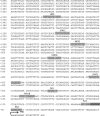Transcriptional regulation of the novel Toll-like receptor Tlr13
- PMID: 19487701
- PMCID: PMC2742818
- DOI: 10.1074/jbc.M109.022541
Transcriptional regulation of the novel Toll-like receptor Tlr13
Abstract
Little has been known about Tlr13 (Toll-like receptor 13), a novel member of the Toll-like receptor family. To elucidate the molecular basis of murine Tlr13 gene expression, the activity of the Tlr13 gene promoter was characterized. Reporter gene analysis and electrophoretic mobility shift assays demonstrated that Tlr13 gene transcription was regulated through three cis-acting elements that interacted with the Ets2, Sp1, and PU.1 transcription factors. Furthermore, our work suggests that these transcription factors may cooperate, culminating in maximal transcription of the Tlr13 gene. In contrast, NF-kappaB appeared to act as an inhibitor of Tlr13 transcription. Overexpression of Ets2 caused a strong increase in the transcriptional activity of the Tlr13 promoter; however, overexpression of NF-kappaB p65 dramatically inhibited it. Additionally, interferon-beta is capable of acting Tlr13 transcription, but the activated signaling of lipopolysaccharide/TLR4 and peptidoglycan/TLR2 strongly inhibited the Tlr13 gene promoter. Thus, these findings reveal the mechanism of Tlr13 gene regulation, thereby providing insight into the function of Tlr13 in the immune response to pathogen.
Figures








Similar articles
-
Characterization of the infection-responsive bovine lactoferrin promoter.Gene. 2005 Jun 20;353(1):107-17. doi: 10.1016/j.gene.2005.04.016. Gene. 2005. PMID: 15935571
-
Toll-like receptor 2 and 4 (TLR2 and TLR4) agonists differentially regulate secretory interleukin-1 receptor antagonist gene expression in macrophages.J Biol Chem. 2002 May 17;277(20):17448-56. doi: 10.1074/jbc.M111847200. Epub 2002 Mar 4. J Biol Chem. 2002. PMID: 11877429
-
PU.1 and interferon consensus sequence-binding protein regulate the myeloid expression of the human Toll-like receptor 4 gene.J Biol Chem. 2000 Mar 31;275(13):9773-81. doi: 10.1074/jbc.275.13.9773. J Biol Chem. 2000. PMID: 10734131
-
Vasoactive intestinal peptide suppresses toll-like receptor 4 expression in macrophages via Akt1 reducing their responsiveness to lipopolysaccharide.Mol Immunol. 2008 May;45(10):2970-80. doi: 10.1016/j.molimm.2008.01.023. Epub 2008 Mar 11. Mol Immunol. 2008. PMID: 18336909
-
NFkappaB and Sp1 elements are necessary for maximal transcription of toll-like receptor 2 induced by Mycobacterium avium.J Immunol. 2001 Dec 15;167(12):6924-32. doi: 10.4049/jimmunol.167.12.6924. J Immunol. 2001. PMID: 11739511
Cited by
-
Investigation of Gene Networks in Three Components of Immune System Provides Novel Insights into Immune Response Mechanisms against Edwardsiella tarda Infection in Paralichthys olivaceus.Animals (Basel). 2023 Aug 7;13(15):2542. doi: 10.3390/ani13152542. Animals (Basel). 2023. PMID: 37570350 Free PMC article.
-
Fine-scale analysis of parasite resistance genes in the red flour beetle, Tribolium castaneum.Genetics. 2013 Sep;195(1):253-61. doi: 10.1534/genetics.113.153205. Epub 2013 Jun 14. Genetics. 2013. PMID: 23770699 Free PMC article.
-
Lipopolysaccharide-induced miR-1224 negatively regulates tumour necrosis factor-α gene expression by modulating Sp1.Immunology. 2011 May;133(1):8-20. doi: 10.1111/j.1365-2567.2010.03374.x. Epub 2011 Feb 14. Immunology. 2011. PMID: 21320120 Free PMC article.
-
Toll-like receptors involved in the pathogenesis of experimental Candida albicans keratitis.Invest Ophthalmol Vis Sci. 2010 Apr;51(4):2094-100. doi: 10.1167/iovs.09-4330. Epub 2009 Nov 20. Invest Ophthalmol Vis Sci. 2010. PMID: 19933194 Free PMC article.
-
Rapid temporal dynamics of transcription, protein synthesis, and secretion during macrophage activation.Mol Cell Proteomics. 2014 Mar;13(3):792-810. doi: 10.1074/mcp.M113.030916. Epub 2014 Jan 6. Mol Cell Proteomics. 2014. PMID: 24396086 Free PMC article.
References
-
- Janeway C. A., Jr., Medzhitov R. (2002) Annu. Rev. Immunol. 20, 197–216 - PubMed
-
- Aderem A., Ulevitch R. J. (2000) Nature 406, 782–787 - PubMed
-
- Akira S., Uematsu S., Takeuchi O. (2006) Cell 124, 783–801 - PubMed
-
- Beutler B. (2002) Curr. Opin. Hematol. 9, 2–10 - PubMed
-
- Underhill D. M., Ozinsky A. (2002) Curr. Opin. Immunol. 14, 103–110 - PubMed
Publication types
MeSH terms
Substances
Grants and funding
LinkOut - more resources
Full Text Sources
Other Literature Sources
Molecular Biology Databases

